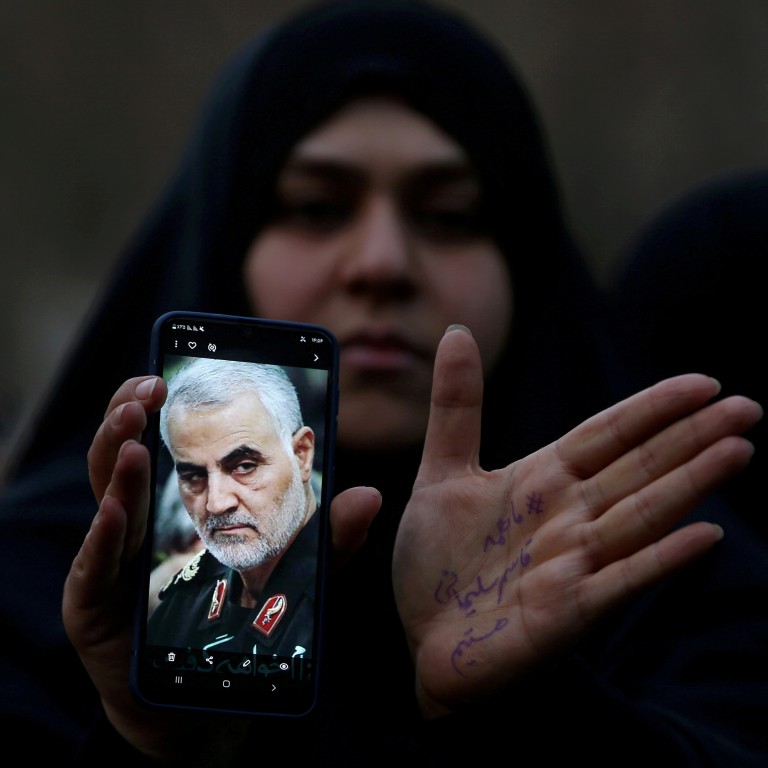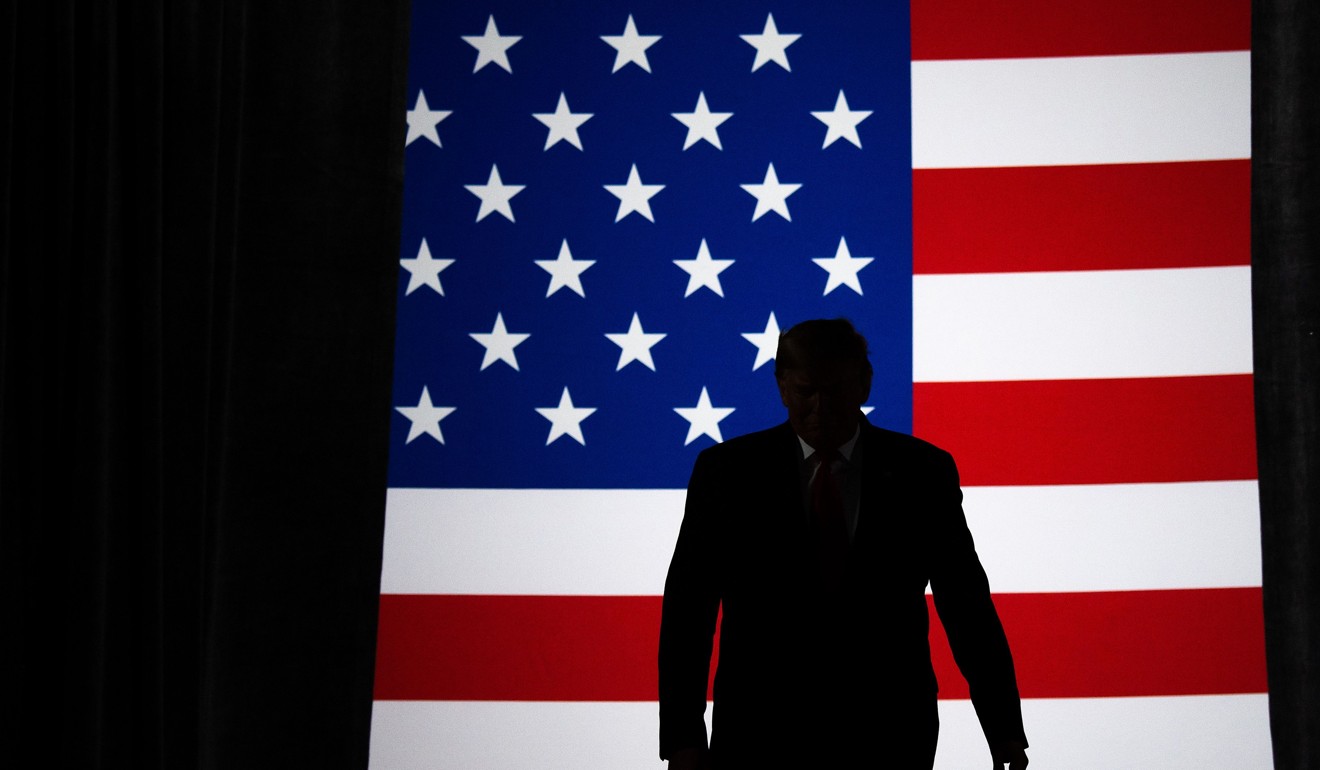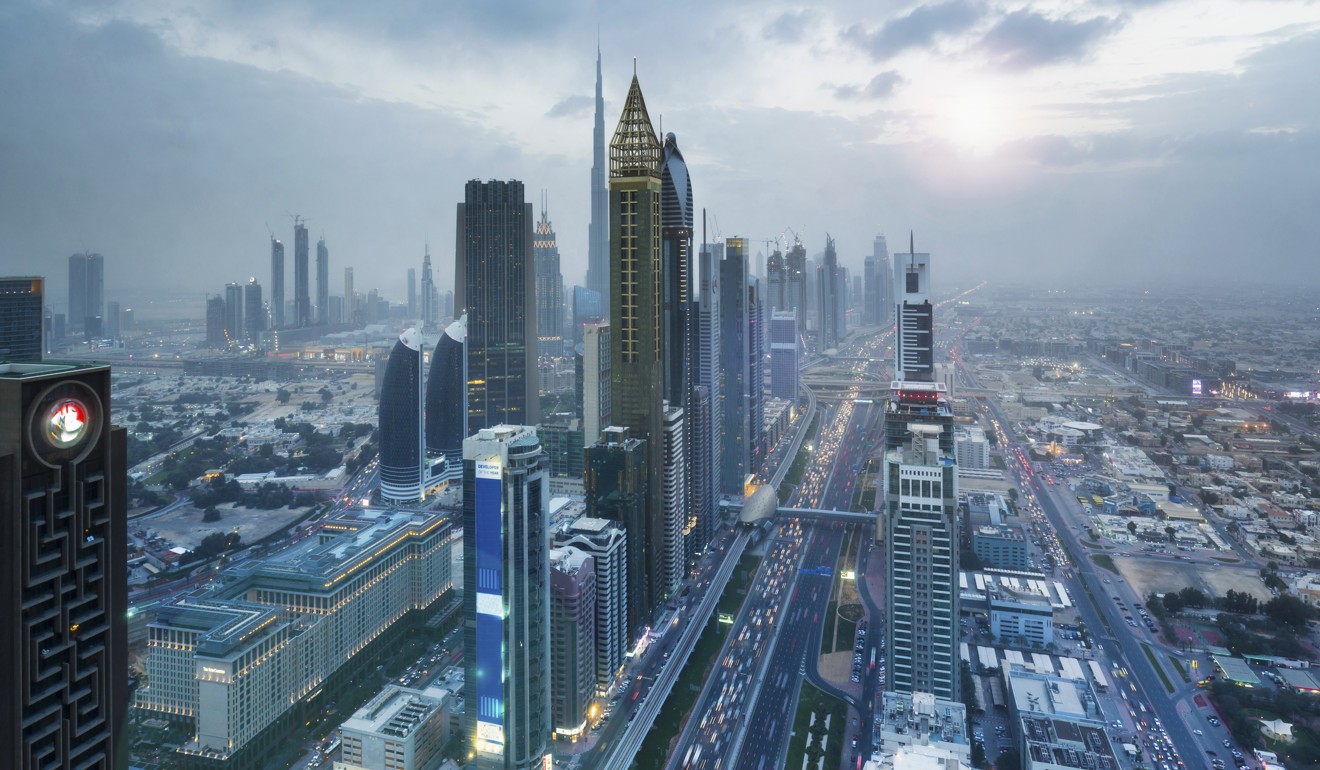
US-Iran crisis: How China gains from Donald Trump’s Middle East blunder
- Conflict between Tehran and Washington has profound implications for Asia-Pacific economies dependent on the Gulf for oil
- But it strengthens Beijing’s hand in the region and provides cover for a greater Chinese military presence
Iranian foreign affairs minister Javad Sharif described the response to the US assassination of Tehran’s top general as “proportionate measures in self-defence”, and said Iran was not seeking further escalation or war.
But the social media of the powerful Islamic Revolutionary Guard Corps (IRGC), the parent organisation of Soleimani’s Quds Force, was far less restrained in its outlook. “The attacks on the Ain al-Assad and Arbil bases are, in fact, attacks on the command and control infrastructure, detection, radar, electronic warfare and, more so, the American brains, eyes and ears in the region,” it said.
The next wave of Iranian strikes “will be completely sweeping and much more effective, if necessary”, the IRGC warned. It went on to identify Haifa in Israel and Dubai in the United Arab Emirates as next on the target list. Along with Saudi Arabia, the three countries are Iran’s greatest foes and America’s closest allies in the region.
These contradictory messages suggest that Supreme Leader Ali Khamenei, who personally oversaw the ballistic missile launches, could unleash the hardline IRGC if the relatively weak government of President Hassan Rowhani cannot salvage the situation diplomatically.
This US-Iran crisis was decades in the making
In Tehran’s convoluted power structure, the IRGC acts as the cutting edge of the all-powerful ayatollahs, and is not answerable to the elected government. Soleimani was especially close to Khamenei, and clearly outranked Rowhani and his elected predecessors in the pecking order.
Washington has also pinpointed prospective Iranian targets to be struck in the event of a further escalation. Influential Republican senator Lindsey Graham had previously warned that the US could destroy Iran’s oil refineries if further provoked.
Having spoken to Trump immediately after Iran’s missile attacks on Iraqi bases hosting US troops, he reiterated this threat to Tehran: “Your fate is in your own hands … you continue this crap, you are going to wake up one day out of the oil business.”

CAUSE FOR CONCERN
For China and other major Asia-Pacific economies, the implications are profoundly worrisome. They depend on the Gulf for more than half of their oil and more than a quarter of their liquefied natural gas supplies.
After Iranian exports were hit by unilateral US sanctions last year, China turned to Iraq to fill the gap. But with Iraq being turned into a proxy battlefield by the US and Iran, any further escalation could cut off oil supplies through the Shatt al-Arab, the narrow waterway squeezed between the borders of Iran and Kuwait.
Political analysts focused on the region say the impact of an Iraqi shutdown would be mitigated by the existing global oil-supply glut. However, in the event of the type of US riposte described by senator Graham, and particularly if US forces based in the Gulf’s Arab countries become involved, all oil export terminals in the region would become vulnerable to Iranian retaliation.
Singapore Airlines, Malaysia Airlines among carriers avoiding Iran airspace after missile attack
That was clearly signalled by the drones that attacked two Saudi Aramco oil refineries in September, knocking out half of Saudi Arabia’s export capacity for weeks.
The attack was claimed by Yemen’s Houthi rebels, who are funded and armed by the late Soleimani’s Quds Force. However, a US investigation found that the drones had attacked from the north, the opposite direction to far-off Yemen, suggesting the air strikes had been launched either from Iran or by its allied militias in Iraq.

Arif Rafiq, president of New York-based risk advisers Vizier Consulting, said top non-Opec producers such as Russia and the US could step up oil production to mitigate short-term shocks to the market from a disruption in supplies from the Gulf.
“China and other Asia-Pacific buyers can also rely to some extent on their strategic oil reserves. But they are vulnerable to disruptions to shipments of oil varieties originating from Iraq that some of its refineries depend on,” he told This Week In Asia.
However, China’s economic interests in the Gulf far exceed its dependency on energy imports. Between 2000 and 2017, its trade with the six-member Gulf Cooperation Council (GCC) ballooned from US$10 billion a year to US$150 billion.
Parallel to that, Chinese foreign direct investment in the GCC – which comprises Bahrain, Kuwait, Oman, Qatar, Saudi Arabia and the UAE – came to nearly US$90 billion between 2005 and 2017, according to Jonathan Fulton, assistant professor of political science at Abu Dhabi’s Zayed University.
As Iran attacks, the US forgets: Soleimani was once on its side
Likewise, China’s bilateral trade with Iran surged from about US$2 billion in 2000 to some US$27 billion in 2017, while Chinese investments in the Islamic republic exceeded US$27 billion between 2005 and 2018.
Dubai, the Gulf’s commercial capital, has become “Hong Kong west”, according to Afshin Molavi, senior fellow at the Johns Hopkins SAIS Foreign Policy Institute. It is now home to more than 3,000 Chinese firms, compared with just 18 in 2005, and 300,000 Chinese nationals. China even enjoys a trade surplus with the UAE.
These firms from China have been positioned to exploit Dubai’s standing as the region’s aviation and maritime hub. Molavi said Chinese nationals based there occupy an estimated 30 per cent of all Africa-bound flights operated by Emirates and other airlines, with Dubai seen as a base for Chinese firms to pursue their extensive economic interests in Africa.

ENTER THE BELT AND ROAD
China’s focus on commercial transport hubs is also evident in the plans it has for the region – plans related to its Belt and Road Initiative. At a 2018 meeting at the China-Arab States Cooperation Forum, Beijing laid out its “industrial park-port interconnection, two-wheel and two-wing approach”.
Under these plans, Chinese consortiums are to build industrial estates alongside ports in the UAE, Oman, Saudi Arabia and Egypt, providing Beijing with a chain of strategically located hubs around the Gulf, Arabian Sea and Red Sea, and at the mouth of the Suez Canal.
From there, the maritime silk route would be connected to the Chinese-operated eastern Mediterranean hub of Piraeus, Greece. Shanghai International Port Group has won a contract to take over the management of Israel’s Haifa port from next year.
China will continue to play both sides of the Persian Gulf divide, reaping long-term, strategic gains from America’s misadventures in the Middle East
The IRGC’s identification of Dubai and Haifa as targets highlights China’s growing exposure to the Middle East conflicts. Analysts say the brewing situation in the Gulf, along with Trump’s vow to pull US forces out of the region, will force China to take a more prominent role.
“I think the trade war combined with ongoing uncertainty about the US’ role in the region makes it more likely that China will start to take more responsibility for securing its interests in the Middle East,” said Fulton of Zayed University, who is also the author of China’s Relations with the Gulf Monarchies.
To date, China’s burgeoning trade and investment in the Gulf have been facilitated by the security umbrella provided by the US, which has military bases in each Arab country facing Iran.

China’s role as a trusted second-tier actor in the region was instrumental in persuading Iran to agree to the 2015 nuclear deal. Trump pulled out of it in May 2018, imposing harsh sanctions as part of a “maximum pressure” campaign to force Iran to agree to tougher terms than those set in the Joint Comprehensive Plan of Action (JCPOA). In doing so, he set the stage for the ongoing escalation.
In the immediate aftermath of Soleimani’s assassination, and Iran’s subsequent announcement it would no longer adhere to uranium-enrichment limits, Chinese foreign ministry spokesman Geng Shuang scolded the US for having practically “forced” Iran to end its commitments to the JCPOA. He said Beijing would undertake “relentless efforts” to save the 2015 deal and avert greater conflict in the Gulf.
Soleimani killing: Iran’s options for revenge on Trump aren’t limited to its military
After the exchange of air raids by the US and Iran, a window of diplomatic opportunity may be open for China to pursue, especially after Japanese Prime Minister Shinzo Abe cancelled his scheduled trip to Tehran in the aftermath of its retaliatory ballistic missile strikes on US bases in Iraq.
But China will continue to act in concert with other JCPOA signatories, particularly France and Russia, as long as the US dominates the military equation in the Gulf.
“For now everything flows through Washington, but eventually we’re likely to see a larger role for a lot of states – Russia, India and China certainly – and China has carefully cultivated relations with all sides of Middle Eastern rivalries,” said Zayed University’s Fulton. “That it doesn’t have the same historical baggage presents an opportunity to be seen as an honest broker in the way that some Western states cannot.”
BEIJING’S WAITING GAME

The additional ships would use China’s military base in the tiny Red Sea state of Djibouti, which also hosts American, French, Italian and Japanese naval facilities. From there, the PLA Navy could provide escorts to Chinese-owned tankers and container ships passing through the region’s two strategic chokepoints: the Strait of Hormuz at the mouth of the Persian Gulf, and Bab el-Mandeb, the entrance to the Red Sea, which is vulnerable to attack by Iran-backed Houthi rebels.
The US, major European Union states, India and Japan have already initiated such maritime security arrangements, so an increased Chinese naval presence would not be viewed as threatening by those geopolitical rivals.
Political analysts believe Beijing stands to gain strategically by continuing to play a waiting game in the Middle East, especially if the Trump administration’s drastic actions precipitate a further escalation or, conversely, a thinning of the American military presence.
“China will continue to play both sides of the Persian Gulf divide, reaping long-term, strategic gains from America’s misadventures in the Middle East. It is in an optimal position, serving as the diplomatic, economic and military alternative to the US for many states in the region,” said risk adviser Rafiq, who is also a non-resident fellow at the Middle East Institute, a Washington think tank.
For the time being, however, the situation in the region remains highly volatile and subject to the whims of Trump and Iran’s ayatollahs.
“Iran has not yet fully figured out how to respond to Soleimani’s death. But it was under pressure to do something quick, so it engaged in a very cautious symbolic move. Actual retaliatory attacks via proxies are still to come,” said Kamran Bokhari, vice-president for Middle Eastern and South Asian affairs at Stratfor, an American geopolitical intelligence platform.
Equally, the behaviour of the current US administration “has severely hampered opportunities for diplomacy to function”, said Fulton of Zayed University.
“If a conflict were to break out, there are just too many unclear variables to be able to predict how it would play out,” he said. “Any conflict between Iran and the US would have enormous consequences for the global economy, energy markets and political order. It’s in China’s interests – and everyone else’s – to try to see that this doesn’t happen.” ■

